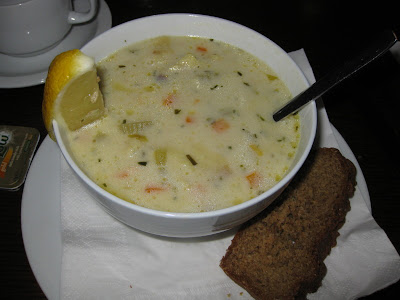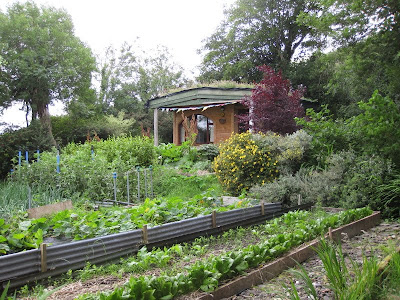July 15-17
I tend to be a creature of habit, and introverted; I usually find it difficult to talk to people. But, I have always enjoyed attending my high school reunions: The people are familiar, even if I don't really know them well, and I manage—from the vantage point of time and distance—to filter out most of the negatives from that period of my life. I suspect I have a lot of company on that point: Who would willingly repeat their teen-age years?
I missed my 50th reunion last October, as we had already embarked on our year-long odyssey by then. So, I was delighted when Stan Sayles, a friend and former classmate, contacted me about a mutual acquaintance from high school, John Clark. He said I should read John's biographical entry in the reunion notebook: “He has had a really interesting life.” I read; he has. I decided to contact him. We began an email dialog which culminated in a plan to visit John and his lovely wife, Helena, in their home on the Dingle Peninsula in Ireland.
I did not really know John before this email exchange. I remember that a couple of my friends liked him way back when; my impression of him back then, based on gut reaction but little real input, was that he was a “really nice guy.” This was reinforced by our electronic correspondence. So, I had no hesitation in grasping this opportunity to get together, especially since the Peninsula was already a destination point. Good decision.
It turns out that John and I share a love of books—though he actually reads, while I tend to use osmosis to derive benefits from text. We are also both frustrated journalists: We both decided against that as a career choice when we discovered how difficult it would be to earn a living wage in that field. (I think we both have regrets about this choice.) And, we both love History—again, though, my interest is far more passive than his. I had a most enjoyable time getting to know John and having the opportunity to hear about the course of his life as he spent time in such places as Prague, Moscow and Ireland. Once more it is people as much as places that are making this trip memorable.

Shortly after arriving at his home in Upper Teer, it was time for a trip to Murphy's Pub to meet Paddy the publican and John's other buddies there. John and I each had a Guinness pint and Claire had a glass of Smithwick's. It was definitely an authentic experience.
John graciously offered to take us to dinner at Ashe's in Dingle Town. I ordered the langustina (crayfish?); Claire had seared Tuna and John had steak. It was, by far, our best meal in Ireland so far.


John had offered to take us on a tour of the Dingle Peninsula on our second day. We had hoped to take a boat out to Skellig Michael; but, the boats were not taking off that day—due to poor weather conditions. We had an alternate boating trip to the Blasket Islands planned and decided to first visit the Visitor Center after we had explored one of the area's ring forts and a site with several beehive churches that have stood here for over 4,000 years. We found a cross on one of the rocks from early Christian times.


The Blasket Island Visitor Center had a wonderful 20 minute film on the island, along with a guided tour of the exhibits and a model of the village. The Island has been inhabited for many years; but, the most recent settlements date from the mid-nineteenth century. They did such an excellent job in the center that we decided we did not need to go out to the island. John had generously purchased four books to enhance our enjoyment of the area: Dingle In Pictures, Blasket Memories, The Islandman and The Pocket Guide to The Great Blasket Island. By the time I finish these, I should be an expert on the area!
Blasket Island

Dingle in Pictures is fascinating because it has so many pictures of the sunny beaches and bathers—who would have guessed? Blasket Memories has stories by and about Islanders that explain their harsh and uneven way of life—times were usually boom or bust. The Islandman is a biographical work by Tomas O'Crohan who wanted “to set down the character of the people about me so that some record of us might live after us, for the like of us will never be seen again.” He was a master of old Irish and taught it to scholars who came to him from different countries. The book was originally published in Gaelic. The Pocket Guide shows the location of the Island in relation to the mainland as well as the sites of the houses and buildings in the settlement.
A curragh is a type of boat used for a time on the Island. A similar type of boat was used in the time of St. Brendan in the 7th century. Some believe he sailed it all the way to Newfoundland!
It is curious that the remaining residents were resettled from the Island in 1953. This is the same year that Scotland had a similar resettlement from one of its island villages in decline. Since the governments of the two countries are distinct, I suppose this is mere coincidence.
We decided to have lunch before continuing. John wanted to try a new place, but a tour bus had pulled up in front and he decided to avoid them and go to another place he liked: It was closed. So, we marched across the street, took our seats and watched as the tourists from the same bus paraded by on their way to the room in back. At least the seafood chowder was delicious, and so was the brown bread—we are finding it easier to get lovely breads in Ireland than in many of the places we have visited.

Our next stop was the Gallarus Oratory, a perfectly preserved church from the 11th century. Shaped like an upturned boat, the stones tilt downwards on the outside so that rain runs off the building, rather than seeping inside. We also loved the ancient cross and gravesite alongside; but, since there has been no excavation, we cannot be sure of the purpose of the stone field surrounding the cross. The docent was friendly, helpful and oh so Gaelic. His name is Dáithi Ó Sé.
Gallarus Oratory

Celtic Cross

Dáithi Ó Sé

A short distance away, we discovered the ruins of the Kilmalkeder Church. We loved the stone sun dial.

John and Helena prepared a large, delicious meal that evening: Spaghetti with meat sauce, salad with lettuce from their own garden, and cheesecake for dessert. I thought I was in heaven.
After dinner, we marveled at their view, their home and the evening sky and talked about whatever came to mind—movies, politics, books and life.



The following morning we ate breakfast and departed for Maghanaboe, the Valley of the Cows—one of John and Helena's favorite hikes. Although it is located on both private and common land, there is no problem hiking in this area. We walked through mud and water to the end of the valley. I couldn't help noticing how much the velvety mountains reminded me of places in Hawaii. We enjoyed seeing the house that John and Helena considered buying; fortunately for them, title disputes saved them from a lot of expensive work on this money pit.


In front of Mary O’Donnell and her sister, Nora’s house


Glenahoe River


We saw the remains of houses from the nineteenth century; we saw sheep, goats, horses. John introduced us to Noel, a local farmer, his son, Keith, and a fisherman. We returned to our car just as the rain was catching up to us and visited with Tim Sweeney, an expatriate American who runs the Kalyana Retreat Center, a place for Buddhist contemplation. This is a place that frequently draws Helena.
Black Face sheep


Keith

Tim built his own house and the Center, along with a Khuti (small retreatant hut), and flower and vegetable gardens. It is absolutely beautiful.
Khuti hut


We drove to Murphy's Pub for Guinness, Smithwick's, Cider and Toasties—toasted ham and cheese sandwiches. We moved back to home base for a delicious meal of sole stuffed with asparagus, salad and Mississippi mud pie. I must confess: We were treated royally over these several days.
On Sunday, we took our leave—it is sad to say goodbye; but, we are looking forward to our next adventure and thinking more and more about the inevitable end of our journey in six weeks.
May the roof above us never fall in.
And may the friends gathered below it never fall out. ~ Irish blessing


2 comments:
Dia duit ar maidin,
What joy to read about Dingle! Your pictures and dialogue made my stomach ache (a sort of longing) so that it is hurting in a good sense! I loved Dingle, it was one of my favourite spots in all Ireland....
As many times as I have been to Dingle I never gotten to the Blasket Islands either, also because of the bad weather. Makes you realize how isolated the people who lived there were from the mainland. I "fell in love" with the books by Peig Sayers and read them all...An Old Woman's Reflections' being the one that I enjoyed so much. Enough so that my girlfriend and I went looking for her grave and found it. That was a special reverent moment. Slea Head - an American woman had her home there and also wrote a book about who, where and why...she lived there. I remember she was the only one in miles and miles who had Christmas lights in her window, because at that time Ireland wasn't much into Christmas commercialism. And another memory...(among so many) is my girlfriend and I went down Connor Pass...we stopped at the top for the view, left the doors open to my car and within a few moments we had a visitor sitting inside: a mountain goat! Don't think we didn't have one H... of a time getting him out! Some boys stopped and had to help us. And the car STANK! Lots of shoving and pulling and I must admit, laughter! So, shut all doors when stopping and looking at the views in Ireland! Ha, ha.
I can't imagine my life without your blog....you have given me such pleasure, so at the moment, I am not going to even think about it!
Much love to fellow Irish travellers,
Karin
This reader is astounded, keeping pace w/ ur journey that only increases in depth, connection, richness... old friends, gorgeous HORSES!! ~ Buddhist retreat, organic gardens ~
and excellent beer.
Re: stone church, similar temples/homes seem distributed worldwide in corresponding forms going back, in Sardegna, to the Neolithic. Some are called, "Nuraghi". Throughout ur trip the connect-the-dots aspect between cultures who were unlikely to have known each other, provided this reader with an intelligent human as well as geographical map. Thanks for another enjoyable post.
Post a Comment